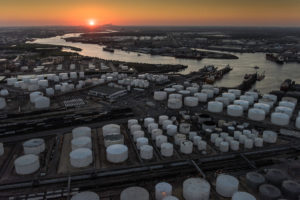
Searchable Database of Public Records on More than 600 Proposed Oil & Gas Projects Across the U.S., including LNG Terminals, Pipelines, Refineries, and Chemical Plants. https://oilandgaswatch.org
Washington, D.C. – The nonprofit, nonpartisan Environmental Integrity Project is announcing the launch of Oil & Gas Watch, a free, public inventory of public records and data that track the rapid expansion of oil, gas, and petrochemical infrastructure throughout the United States.
In less than a decade, fracking and new oil and gas drilling techniques have turned the U.S. into the largest producer of oil and gas in the world. But the buildup of industrial infrastructure does not just involve drilling sites and wells – although that is what reporters most often write about and what people most often associate with oil and gas.
Downstream from those oil and gas wells, a vast web of pipelines, tanks, compressor stations, processing plants, refineries, liquefied natural gas export terminals, and chemical plants is also spreading across the U.S., often outside most news coverage and so outside the consciousness of the public. Russia’s invasion of Ukraine could accelerate some of these projects, especially LNG Terminals. It is this oil and gas infrastructure – and the massive amount of pollution that it produces, out of sight and out of mind – that is the focus of Oil & Gas Watch.
Oil & Gas Watch is currently tracking over 600 projects that were announced or authorized since 2012, and the numbers keep growing. About 333 of these projects have been built over the last decade and are permitted to release over 144 million tons of greenhouse gases per year. An additional 279 projects have not yet been constructed, but have the potential to release nearly 210 million tons of greenhouse gases per year, as well as millions of tons of health-damaging air pollutants like sulfur dioxide and particulate matter. Oil & Gas Watch is also tracking almost 100 pipelines that have been proposed but not yet built and the potential wetlands impacts of those projects.
Oil & Gas Watch is valuable to journalists, academic researchers, community activists, and others because it provides insights and public records on the myriad state and federal environmental approvals that companies must obtain before starting construction or operations. The website also presents a comprehensive picture of how these pollution-heavy industries impact the environment and public health, especially for local communities in Texas, Louisiana, Pennsylvania, New Mexico, and West Virginia, where growth has been most rapid. For each of the oil and gas expansion projects, the website provides data on the income levels and race of local residents and the increased cancer risk that they might face from hazardous air pollutants.
The website features include:
- An interactive, searchable map showing the locations of proposed new and expanding oil, gas, and petrochemical infrastructure projects approved or announced since 2012.
- Searchable, filterable, and downloadable tables to help users find projects, pipelines, and environmental permits.
- Data for each project on permitted emissions of greenhouse gases, sulfur dioxide, nitrogen oxide, particulate matter and other air pollutants, as well as the potential wetlands impacts from construction of pipelines.
- State summary pages that capture the industry’s impact across regions.
- Access to thousands of public records and permits unearthed by EIP’s analysts.
- A user-friendly glossary of industry and regulatory terms.
- An extensive “Frequently Asked Questions” section.
If you have questions or comments, please contact our Oil & Gas Watch staff at ogwatch@environmentalintegrity.org.


